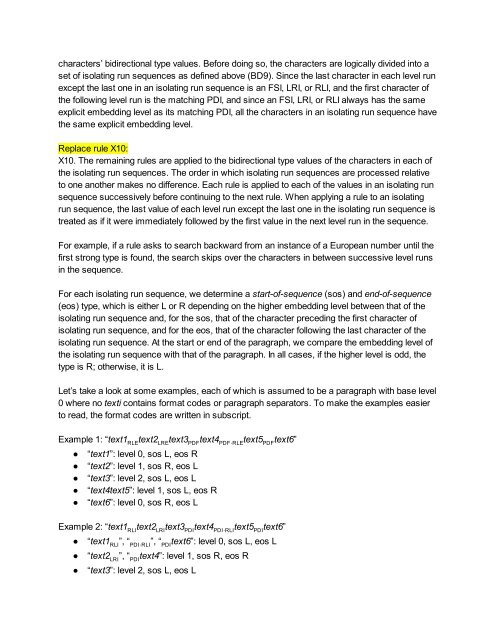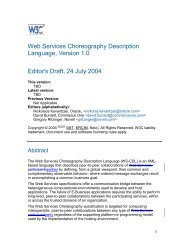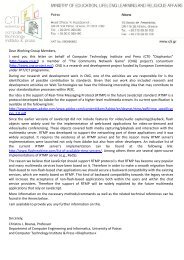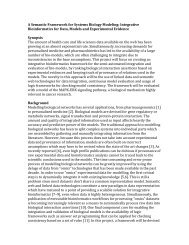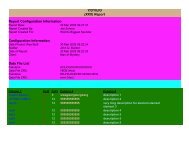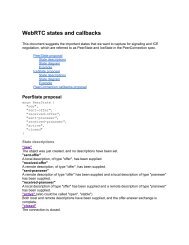A Proposal for Bidi Isolates in Unicode
A Proposal for Bidi Isolates in Unicode
A Proposal for Bidi Isolates in Unicode
Create successful ePaper yourself
Turn your PDF publications into a flip-book with our unique Google optimized e-Paper software.
characters’ bidirectional type values. Be<strong>for</strong>e do<strong>in</strong>g so, the characters are logically divided <strong>in</strong>to a<br />
set of isolat<strong>in</strong>g run sequences as def<strong>in</strong>ed above (BD9). S<strong>in</strong>ce the last character <strong>in</strong> each level run<br />
except the last one <strong>in</strong> an isolat<strong>in</strong>g run sequence is an FSI, LRI, or RLI, and the first character of<br />
the follow<strong>in</strong>g level run is the match<strong>in</strong>g PDI, and s<strong>in</strong>ce an FSI, LRI, or RLI always has the same<br />
explicit embedd<strong>in</strong>g level as its match<strong>in</strong>g PDI, all the characters <strong>in</strong> an isolat<strong>in</strong>g run sequence have<br />
the same explicit embedd<strong>in</strong>g level.<br />
Replace rule X10:<br />
X10. The rema<strong>in</strong><strong>in</strong>g rules are applied to the bidirectional type values of the characters <strong>in</strong> each of<br />
the isolat<strong>in</strong>g run sequences. The order <strong>in</strong> which isolat<strong>in</strong>g run sequences are processed relative<br />
to one another makes no difference. Each rule is applied to each of the values <strong>in</strong> an isolat<strong>in</strong>g run<br />
sequence successively be<strong>for</strong>e cont<strong>in</strong>u<strong>in</strong>g to the next rule. When apply<strong>in</strong>g a rule to an isolat<strong>in</strong>g<br />
run sequence, the last value of each level run except the last one <strong>in</strong> the isolat<strong>in</strong>g run sequence is<br />
treated as if it were immediately followed by the first value <strong>in</strong> the next level run <strong>in</strong> the sequence.<br />
For example, if a rule asks to search backward from an <strong>in</strong>stance of a European number until the<br />
first strong type is found, the search skips over the characters <strong>in</strong> between successive level runs<br />
<strong>in</strong> the sequence.<br />
For each isolat<strong>in</strong>g run sequence, we determ<strong>in</strong>e a start-of-sequence (sos) and end-of-sequence<br />
(eos) type, which is either L or R depend<strong>in</strong>g on the higher embedd<strong>in</strong>g level between that of the<br />
isolat<strong>in</strong>g run sequence and, <strong>for</strong> the sos, that of the character preced<strong>in</strong>g the first character of<br />
isolat<strong>in</strong>g run sequence, and <strong>for</strong> the eos, that of the character follow<strong>in</strong>g the last character of the<br />
isolat<strong>in</strong>g run sequence. At the start or end of the paragraph, we compare the embedd<strong>in</strong>g level of<br />
the isolat<strong>in</strong>g run sequence with that of the paragraph. In all cases, if the higher level is odd, the<br />
type is R; otherwise, it is L.<br />
Let’s take a look at some examples, each of which is assumed to be a paragraph with base level<br />
0 where no texti conta<strong>in</strong>s <strong>for</strong>mat codes or paragraph separators. To make the examples easier<br />
to read, the <strong>for</strong>mat codes are written <strong>in</strong> subscript.<br />
Example 1: “text1 RLE<br />
text2 LRE<br />
text3 PDF<br />
text4 PDF‧RLE<br />
text5 PDF<br />
text6”<br />
●<br />
●<br />
●<br />
●<br />
●<br />
“text1”: level 0, sos L, eos R<br />
“text2”: level 1, sos R, eos L<br />
“text3”: level 2, sos L, eos L<br />
“text4text5”: level 1, sos L, eos R<br />
“text6”: level 0, sos R, eos L<br />
Example 2: “text1 RLI<br />
text2 LRI<br />
text3 PDI<br />
text4 PDI‧RLI<br />
text5 PDI<br />
text6”<br />
●<br />
●<br />
●<br />
“text1 RLI<br />
”, “ PDI‧RLI<br />
”, “ PDI<br />
text6”: level 0, sos L, eos L<br />
“text2 LRI<br />
”, “ PDI<br />
text4”: level 1, sos R, eos R<br />
“text3”: level 2, sos L, eos L


